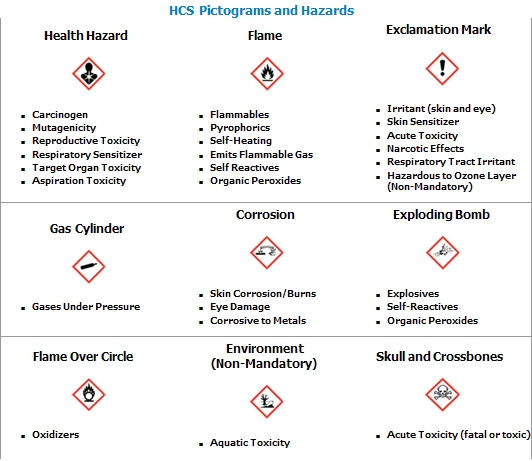





Return to news>>GHS, SDS and Employers: Information you need to know.
Jan 07, 2015
Source: HazCommpliance LLC
WHAT?
OSHA’s Hazard Communication Standard (1910.1200) has undergone some changes recently to align it with a global initiative (GHS) to help manage the risks associated with chemicals in the workplace with the help of the new SDS.
The Globally Harmonized System for Classification and Labeling of Chemicals, otherwise known as the GHS, provides a common approach for countries to follow when identifying the hazards associated with chemicals and the methods for providing that information to end-users (such as employers and their employees).
A summary of the major changes for end users are as follows:
Manufacturers, suppliers and distributors still have a duty to provide a copy of a Material Safety Data Sheet (MSDS) to workplaces, however the format of the MSDS will be different, as will the name. MSDS’s will be referred to as Safety Data Sheets (SDS) and will contain 16 sections that describe the important information about the chemical. Packaging and container labels will also be changing in appearance and content.
Chemicals will now be classified into 2 categories.
Within these sections, the chemical will be assessed to determine how hazardous it is and be given a further classification from 1-4 (with 1 being the most hazardous and 4 being the least hazardous). This differs from the commonly used NFPA ratings where ‘4’ was the most hazardous classification.
One of the main changes will be the use of different hazard symbols, called ‘pictograms’. These pictograms will be displayed on labels and SDS to help convey the main hazards. Pictograms will have a black and white symbol that best represents the hazard classification, surrounded by a red diamond border. Further to this, labels must display the appropriate signal word, relevant hazard statements and precautionary statements.

WHY?
The use of the GHS pictograms, signal words, hazard and precautionary statements will help end-users to understand the hazards associated with the chemicals they use as each chemical label and SDS will have a similar appearance. This means that employers and employees required to read and understand the labels and SDS can easily find the relevant information in a familiar format.
WHEN?
Deadline overview:
The new GHS system for labels and SDS will be phasing in over the next couple of years (until June 2016). During the transition period, employers can either comply with 1910.1200 (the final standard) or the current standard or both, but there are some dates that employers need to be aware of.
By December 1st, 2013 employers must train their employees on the new label elements and SDS format. As manufacturers/suppliers will be providing the new format labels and SDS progressively during the phase-in period, these will start filtering into US workplaces. It is important that employees are familiar with them so they can understand how to access important safety information effectively. By June 2016, employers must be using the GHS compliant formatted SDS and labels and have provided their employees with additional training for any newly identified physical or health hazards.
HOW?
HazCommpliance, LLC offers GHS and SDS compliance solutions. If you are an employer, we conduct chemical inventories and build your own MSDS/ SDS binder for you. As we receive the updated versions of the SDS, it is then added to your online account. Compliance level is tracked and the products with SDS’ are identified.
If you are a manufacturer, HazCommpliance, LLC offers MSDS to SDS conversions. We will research updated information for your chemicals and revise the SDS to the new format, including any pertinent signal words, key phrases, or hazard classifications necessary.
Don’t wait until it’s “crunch time”!!!
For more information on safety training or what trainings HazCommpliance can offer your organization please email us at